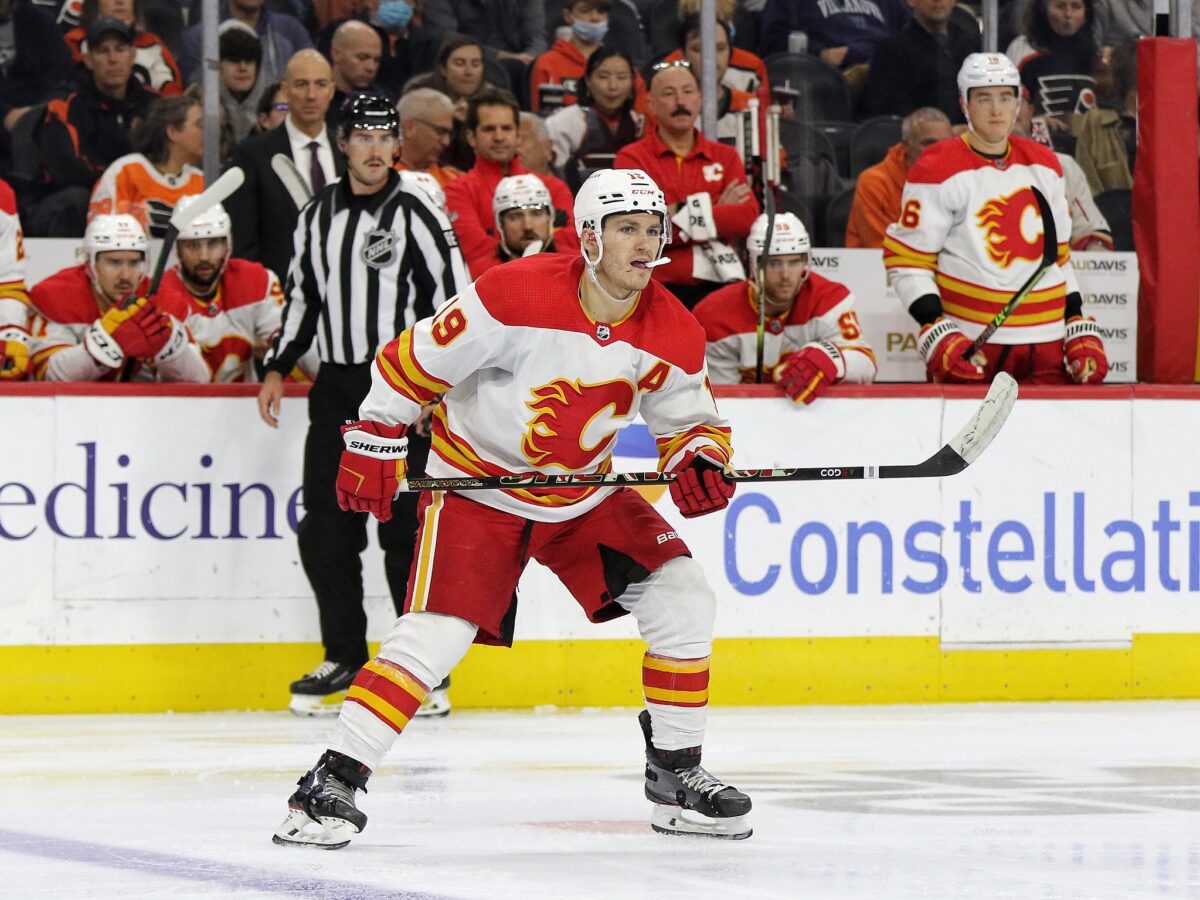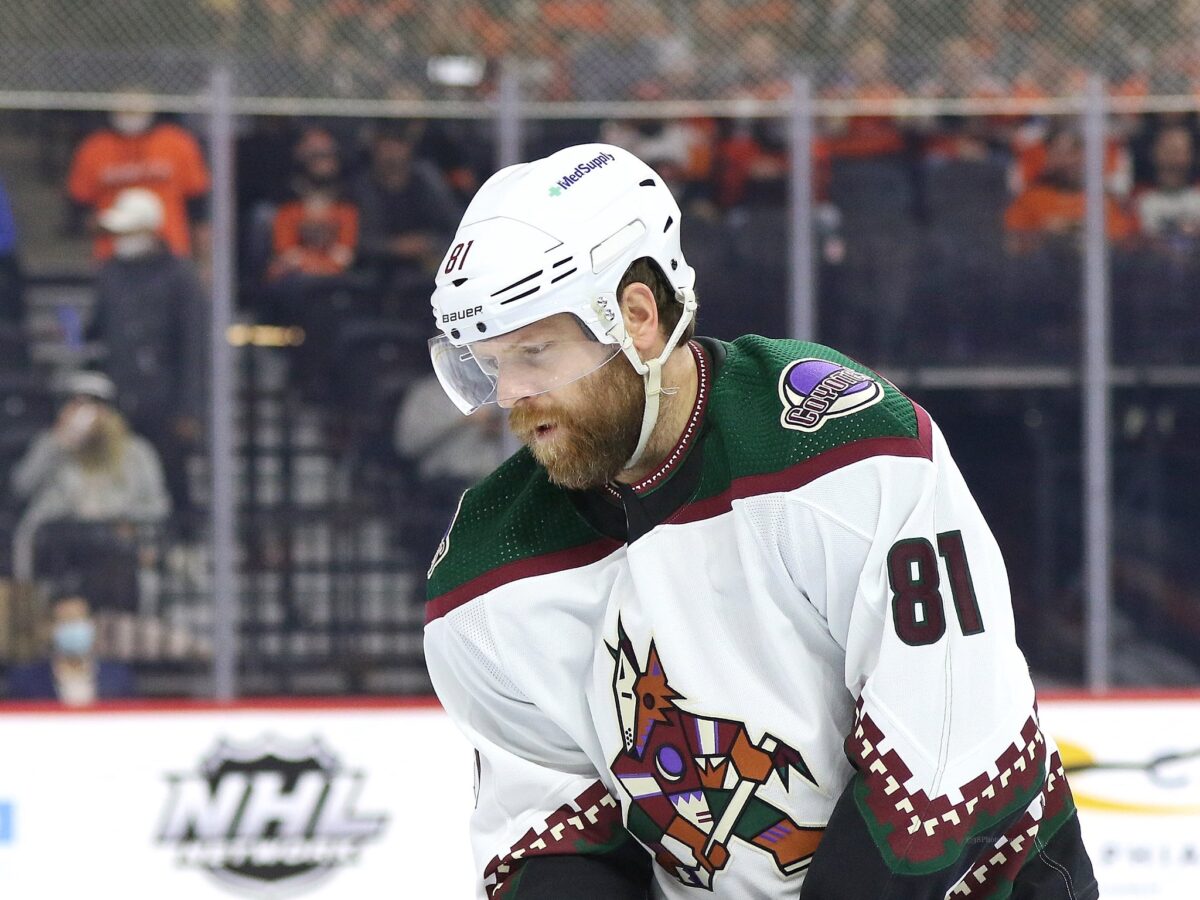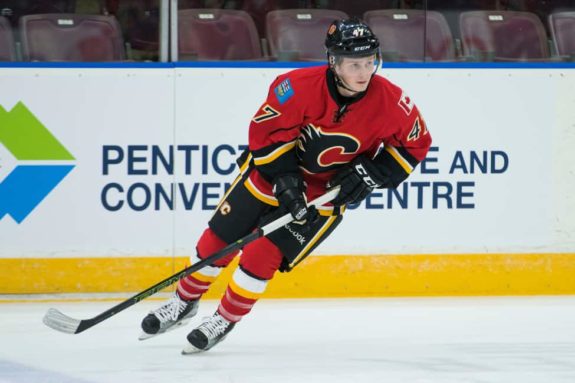I wrote recently that even though the Calgary Flames have had a hot start to the season, there are still problems they need to fix. One of them is that they don’t score enough goals. Flames head coach Darryl Sutter said exactly that in a post-game presser following their loss to the Montreal Canadiens on Remembrance Day observing that, “when we were scoring three and a half goals a game, (at the start the season) that’s not a sustainable number. We need a little more offence”.
Stronger Right Wing Key to More Goals
Several readers pointed out to me that the Cowtown boys need a better “one-two punch” with more secondary scoring. They fear that other teams will figure out how to shut down the Flames’ top line of Johnny Gaudreau, Elias Lindholm and Matthew Tkachuk.

It looks like they already have with that line mustering just six points between them in the five games leading up to the Flames’ blow-out win over the Buffalo Sabres on Thursday night. While the team has scored 14 goals in its last six games, an average of 2.3 goals-per-game, their fans need to consider that nine of those were scored against the hapless Ottawa Senators and Sabres. My beer league team could score on those two teams! Take out the goals scored in Ottawa and Buffalo and the Flames are scoring an average of just 1.25 goals per game.
To spread out point production, some readers told me that that the team needs to become stronger on its right side. For the most part the Flames are making do with left-handed shots playing on the right side (think Andrew Mangiapane and Tkachuk), and recycled centremen slotted at right wing (think Trevor Lewis and Tyler Pitlick). As one reader put it, “the Flames have needed a right-shot, right winger for years – a true sniper. A player who’s dangerous shooting from just about anywhere, preferably a right-shot, is what the Flames need most now”.
Related: Flames Have Problems to Fix Despite Early Success
So how can the Flames add enough fire power on their starboard side so that it makes a difference this season? The short ugly answer is: with difficulty. They can either trade for a right winger, enter the pending free agency market for one, or tap their prospect pool in the hope a rookie or two could make an immediate impact. None of these options offers a panacea.
Bolstering the Flames’ Right-Side via Free Agency Market
Next July a number of players who could bolster the Flames’ right side will come onto the market as unrestricted free agents (UFA). Yet the Flames don’t have to wait until then to acquire one of them.
The list includes two-time Stanley Cup winner and alternate captain of the Arizona Coyotes, Phil Kessel, Philadelphia Flyers’ captain, Claude Giroux, David Perron of the St. Louis Blues, and Nashville Predators’ alternate captain, Filip Forsberg.

The Stampede City will want somebody on the right side who can tally a figure approaching at least 50 points per season. All of these skaters have demonstrated the ability to do that – season after season. None are a flash in the pan.
The Flames will also want a player no older than 30, and therein lies the rub. The problem with all but 27-year old Forsberg, is that by NHL standards the players cited are well into their dotage. Not only that, but trading for a UFA with less than a season on their contract might mean the Flames get nothing for him if they are unable to reach an agreement on a contract extension. It can be a risky proposition.
Related: Do the Flames Have a Right Wing Issue?
As for Giroux, he is the face of the Flyers, and has never played anywhere else but in the City of Brotherly Love. It’s hard to believe that barring extraordinary circumstances, the Flyers would allow him to leave. That the Coyotes would part with Kessel or the Blues with Perron is not a certainty either, making it tough for Flames general manager Brad Treliving at the negotiating table if he were interested in them.
Of all the options the Flames have in the free agency market, Forsberg is probably their best bet. The Predators face salary cap problems next year and may be willing to unload the imposing 6-foot-2, 212-pound Swede.
You may also like:
- Revisiting the Flames’ Lindholm & Hanifin Trade
- Flames News & Rumors: Cozens, Andersson, Cull & More
- Flames’ Huberdeau Leading the Charge Offensively
- 7 Cool Things About Jarome Iginla: Calgary Flames Hall of Famer
- Flames Defeat Blackhawks 6-4, Shut Down Comeback Effort
Yet when it comes to Forsberg and his current annual salary of $6 million, cap problems are something the Flames and Predators would have in common. Squeezing him under the Flames cap space after signing Gaudreau, Tkachuk and Andrew Mangiapane would be daunting for Treliving.
Strengthening the Flames’ Right Wing With a Trade
If trading for a top notch right winger were easy, the Flames wouldn’t have gone years without one. Pickings are slim and as Treliving admonished hopeful Calgary fans at a press conference before training camp this year, “I can’t click my heels and make things happen. You have to have a trade partner. It doesn’t make any sense for us to give a player away for 50 cents on the dollar. It’s great to say, ‘go get this guy.’ Problem is, this isn’t fantasy hockey. The idea that you can go pick ‘this player’ off the player tree … it doesn’t happen that way.”
To be attractive to the Flames’ brain trust a top-six right winger will not only need to offer 50 plus points a season, but they’d need term on their contract. They also have to be affordable. And therein lies the trouble.
Related: Flames Should Consider Trading for Kyle Palmieri
The Flames projected cap hit now sits at just over $81.2 million, compared to the league salary cap of $81.5 million this year, and the cap is unlikely to rise next year. Assuming the Flames re-sign Tkachuk, Gaudreau and Mangiapane with significant salary increases as they must, and with 13 other players already under contract, I estimate they’ll have about $5.5 million to sign the seven other players they need to round out their roster. Unless they dump significant salary, I don’t see how they could manage to secure a top notch right winger in a trade.
To illustrate the point, 24-year old Brock Boeser will ply his trade on the right wing with the Vancouver Canucks for a little under $6 million per year until his contract expires at the end of the 2022-23 season. David Pastrnak, who becomes a free agent the same year, toils in Beantown on the starboard side tapping the Boston Bruins’ cap limit for just over $6.6 million annually.

There are cheaper options for the Flames to consider. For example, Joonas Donskoi with the Seattle Kraken is a right-hand shot at right wing playing for $3.9 million a year with almost two years of term left on his contract. Still, as the adage goes, you get what you pay for and Donskoi’s best year was back in 2018-19 when he put up 37 points with the San Jose Sharks. This year he’s on track for 30.
In the flat salary cap era of today, a trade is likely to be dollar for dollar meaning that it would be difficult for Treliving to improve the team with a top-six skater on the right-hand side of the roster given the assets he’d be forced to give up to clear the needed cap space.
Could Flames’ Prospects be Salvation for the Right Wing?
The short answer is yes, but not anytime soon. Matthew Phillips and Walker Deuher, both now playing with the Stockton Heat, Calgary’s American Hockey League (AHL) farm team, are the two obvious choices to be inserted on the right side in the bottom-six, but it would be unfair to expect either to have an impact this year.
The only look fans got at Phillips was in a meaningless game at the end of last season. While talented and producing points in Stockton, the knock on the 23-year-old is that at 5-foot-8 and 165-pounds he is too small for the NHL. Some say it’s hard to see how he would fit into the Sutter system.

Walker Deuher saw action last Sunday against the Ottawa Senators and has played a total of 10 games in Stockton. The scouting reports on the 6-foot-2, 210-pound rookie are promising, yet he’s just 23-years old and will need seasoning in the AHL..
No Obvious Fix for the Flames’ Problem at Right Wing
That the Flames need more secondary scoring is obvious to all including their coach. That the solution lies in strengthening their right side is beyond dispute. Even so, there are no easy fixes. Good players don’t come on the market very often and when they do it costs money to sign them. The Flames may have to live with the weakness on their right side until their prospect pipeline offers as solution.